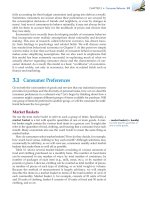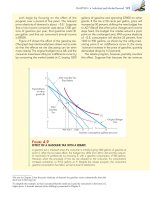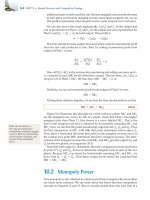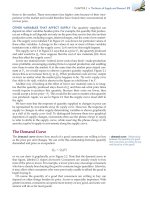(8th edition) (the pearson series in economics) robert pindyck, daniel rubinfeld microecon 130
Bạn đang xem bản rút gọn của tài liệu. Xem và tải ngay bản đầy đủ của tài liệu tại đây (101.58 KB, 1 trang )
CHAPTER 3 • Consumer Behavior 105
EX AMPLE 3. 8 THE BIAS IN THE CPI
In the past decade, there has been growing public
concern about the solvency of the Social Security
system. At issue is the fact that retirement benefits
are linked to the Consumer Price Index. Because the
CPI was a Laspeyres index that could overstate the
cost of living substantially, Congress has asked several economists to look into the matter.
A commission chaired by Stanford University professor Michael Boskin concluded that the CPI overstated inflation by approximately 1.1 percentage
points—a significant amount given the relatively low
rate of inflation in the United States in recent years.15
According to the commission, approximately 0.4
percentage points of the 1.1-percentage-point
bias was due to the failure of the Laspeyres price
index to account for changes in the current year mix
of consumption of the products in the base-year
bundle. The remainder of the bias was due to the
failure of the index to account for the growth of discount stores (approximately 0.1 percentage points),
for improvements in the quality of existing products,
and, most significantly, for the introduction of new
products (0.6 percentage points).
The bias in the CPI was particularly acute when
evaluating the costs of medical care. From 1986
to 1996, the average increase in the CPI was 3.6
percent, but the medical component of the CPI
increased at an average annual rate of 6.5 percent
per year. Thus, one estimate placed the total bias
of the medical insurance part of the CPI at approximately 3.1 percentage points annually. This bias has
enormous policy implications as the nation struggles
to contain medical-care costs and provide health
care to an aging population.16
If any remaining bias in the CPI were to be eliminated, in whole or in part, the cost of a number of
federal programs would decrease substantially (as
would, of course, the corresponding benefits to eligible recipients in the programs). In addition to Social
Security, affected programs would include federal
retirement programs (for railroad employees and military veterans), Supplemental Security Income (income
support for the poor), food stamps, and child nutrition. According to one study, a 1-percentage-point
reduction in the CPI would increase national savings
and thereby reduce the national debt by approximately $95 billion per year in year 2000 dollars.17
In addition, the effect of any CPI adjustments
would not be restricted to the expenditure side of the
federal budget. Because personal income tax brackets are inflation-adjusted, a CPI adjustment decreasing the rate of measured price increase would necessitate a smaller upper adjustment in tax brackets and,
consequently, increase federal tax revenues.
SUMMARY
1. The theory of consumer choice rests on the assumption
that people behave rationally in an attempt to maximize the satisfaction that they can obtain by purchasing a particular combination of goods and services.
2. Consumer choice has two related parts: the study of
the consumer’s preferences and the analysis of the
budget line that constrains consumer choices.
3. Consumers make choices by comparing market baskets or bundles of commodities. Preferences are
assumed to be complete (consumers can compare all
possible market baskets) and transitive (if they prefer
basket A to B, and B to C, then they prefer A to C). In
addition, economists assume that more of each good is
always preferred to less.
15
Michael J. Boskin, Ellen R. Dulberger, Robert J. Gordon, Zvi Griliches, and Dale W. Jorgenson,
“The CPI Commission: Findings and Recommendations,” American Economic Review 87 (May 1997):
78–93. The Bureau of Labor Statistics adopted changes in the measurement of the CPI, but these
changes reduced the bias to only 0.8 or 0.9 percentage points. See, Michael J. Boskin, “Causes and
Consequences of Bias in the Consumer Price Index as a Measure of the Cost of Living,” Atlantic
Economic Journal 33 (March 2005): 1–13.
16
For more information, see Chapters 1 and 2 of Measuring the Prices of Medical Treatments, Jack
E. Triplett, Editor; Washington, D.C.: Brookings Institution Press, 1999 ( />17
Michael F. Bryan and Jagadeesh Gokhale, “The Consumer Price Index and National Savings,”
Economic Commentary (October 15, 1995) at The data have been adjusted
upward using the GDP deflator.









